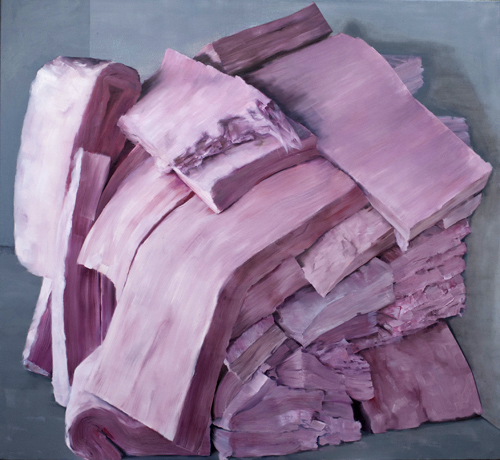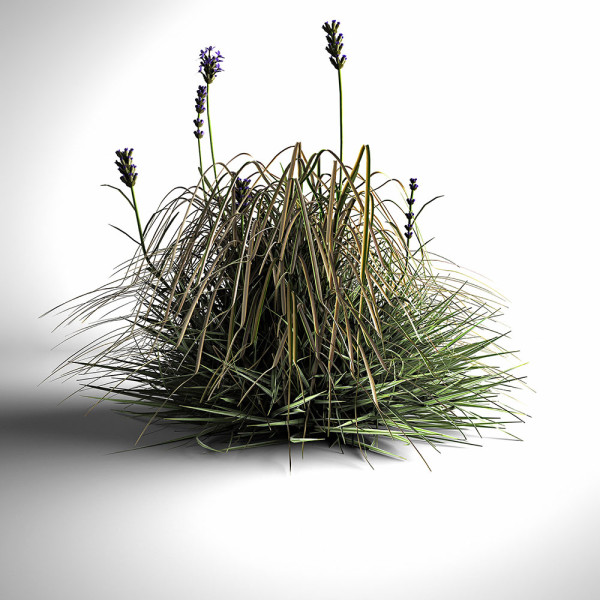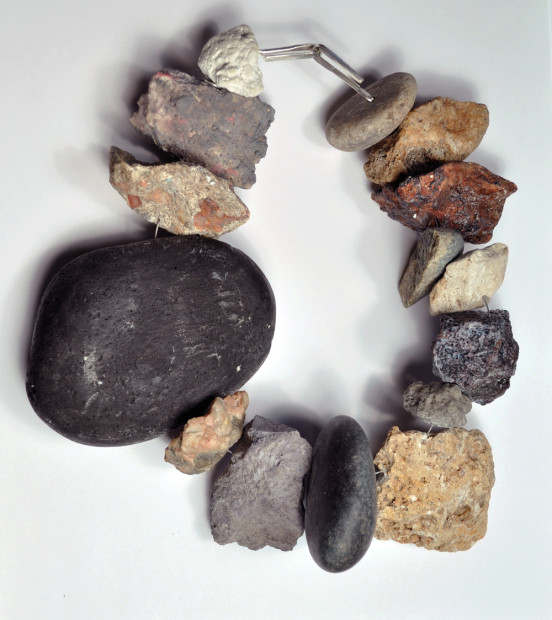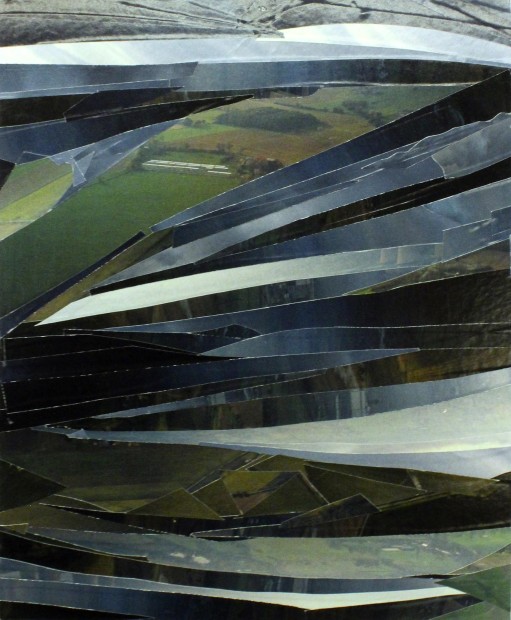Urban Ecologies at the Galveston Art Center is the first curatorial collaboration from Barometry Projects, a Houston-based initiative founded by Anna Walker and Laura Wellen. Featuring 25 works from six artists – some local, some not – the show investigates our built and natural environment and how those two conditions press upon and transform each other.

Thuy-van Vu, Insulation
While many of the pieces in Urban Ecologies focus on interventions into nature, the show opens with Thuy-van Vu’s painting Insulation. Greeting visitors on a wall of its own, the painting also comments on what’s within the walls – the material that fills in the spaces between exterior and interior, holding back one environment and keeping the other in. In the painting, batt insulation – which has to be installed using thick gloves because the fiberglass in it is painful to touch – takes on a soft, gummy character, limp in its casual embrace. Channeling both Wayne Thiebaud and Claes Oldenburg, the painting demonstrates the fantastical aspect of the industrial, remodeling the inorganic into an almost sentient organism.

Krista Birnbaum, Combine (featuring Spartina pectinata)
In 1975, the philosopher Umberto Eco theorized the idea of hyperreality, what he characterized as a particularly American taste for the “real thing” – an unattainable desire that resulted in the fabrication of the absolute fake, the genuine copy. This is another type of ecology, or system, taken up by Krista Birnbaum’s work, in which she produces renderings that represent carefully controlled plant life. The renderings look like photographs, but because they are renderings, Birnbaum has undermined the convention we most associate with photography – its truth value, its claim to be an index of something in the world. Instead, Birnbaum’s representations are the thing itself, because there is no original. When Eco asks where the truth of ecology lies, his question is in reference to the zoos that reconstruct the “natural habitats” of their animal inmates. The result is the taming of the wild. Like that promise of nature made tranquil and docile, Birnbaum’s creations look like the grasses that would populate a well-manicured yard. But instead of being situated in a suburban garden, these virtual representations of plants are surgically removed and pictured against white backgrounds. In the commercial world, the function of these plant elements is to make architectural renderings look more natural. By isolating them, Birnbaum foregrounds the way we construct illusions about an ideal environment. The images do not announce their CGI status, but Birnbaum provides clues in delicate moments where a stem almost seems to poke through the white backdrop, or more overtly when a hedge is interrupted and only an artificial looking shadow fills the void.

Leslie Shershow, Real and Fake Rock Choker
In contrast to Birnbaum’s larger-than-life ethereal images, Leslie Shershow’s jewelry foregrounds its materiality, in part by virtue of its three-dimensionality and its bodily scale. Yet even then, Real and Fake Rock Choker plays with notions of the authentic and synthetic. Some of the rocks are rough, some smooth, some fabricated and some found. If worn around the neck, the choker could be stifling, or just stylish. Walker and Wellen’s inclusion of decorative arts alongside paintings, collage and digital imagery is an unusual and smart decision that expands the idea of ecology with reference to both the arts landscape and the landscape of the body. The piece eschews the preciousness often associated with craft and the mix of natural and man-made rocks suggests questions of value, use, and hierarchy.

Eric Zimmerman, Field No. 34
Eric Zimmerman’s Field series serves as an abstract counterpoint to the insistent figuration of the other works in the show. Derived from found landscape photographs, Zimmerman’s collages rearrange jungles, waterfalls and caves into terrains of optical patterns, vertical strips, and radial vortexes. In Field No. 34, a collage of farmland, Zimmerman interlaces land and sky in arcing swaths that disrupt the geometric regularity of land parceled for agriculture. Zimmerman’s series creates a new kind of mapping of the landscape, in which we feel our way through rather than diagram and measure.
Nature and culture constantly collide in Walker and Wellen’s Galveston exhibition – much like the terrain of the barrier island itself. Barometry Projects is named in part to reference the pressures of fluctuating meteorological systems, but it also speaks to how we measure those systems, and how measurement – like representation – is an imperfect description of shifting conditions. It is at once a thing, yet never the thing itself.
Sandra Zalman is Assistant Professor of Art History at the University of Houston. She was recently awarded a grant from the American Association of University Women to complete her book on the critical and mass cultural reception of Surrealism.
Urban Ecologies will be on view at the Galveston Arts Center thorugh April 12, 2015


